The Khuzait Overhaul is based on the Khazar Khaganate, which ruled over much of the land Southwest of the Ural mountains until the 10th century. While I have chosen kingdoms up to this point which were of the mod's time period, I decided to go with the Khazars on this one because they were a prosperous empire which is one of the few examples of a Turkic people settling without being assimilated into the population. They ruled over a mix of Slavic, Avar and Turkic population with great success until the rise of the Kievan Rus pushed them back and eventually destroyed them.
The Khazars emerged as a power of note during the 8th century and spent almost 80 years at war with the Umayyad and Abbasid Caliphates on their southern border. However, they prospered as a trading hub situated between the Byzantine Empire, Kievan Rus and Persia. The Khazars grew extremely rich and became influenced by the beginnings of feudalism while maintaining some nomadic attributes.
During that time, they secured their Southern border and expanded elsewhere, subjugating the Volga Bulgars, the Alans and other groups which became part of the multicultural state the Khazars rules over.
The Khazars are proabably most famous for having converted to Judaism in the 8th century, however that is not of much importance to us in this context. What is more interesting is that they built fortresses with a very distinct architecture which Taleworlds has tried to reproduce in its depiction of the Khuzaits. The "white forts" of the Khazars were very distinct.
They were also extremely capable armor smiths, and examples of riveted lamellar armor have been found in what used to be Khazaris which predate even the Byzantines' use of similar techniques. They relied heavily on Mounted Archers initially before slowly shifting toward Heavy Shock Cavalry and Infantry, without ever completely abandoning Mounted Archery as an important component in their armies. However, they were unable to resist the rise of Kievan Rus and slowly faded from history. The Khazars are also extremely recognizable for their extensive use of masked helmets, extremely similar to the "Spiked Helmet with Facemask" which exists in the game.
In terms of weaponry, deciding factor of most battles was the bow. Initial exchanges of arrows would largely determine the course of the battle. However, it was rare for the Khazars to have dedicated foot archer, although they often dismounted their horse archers for this purpose. On the other end, mounted Khazars favored the sabre as a primary weapon but later also adopted the spear. Maces had an important role in Khazar society as a mark of wealth and were used extensively in warfare as a way to penetrate thick armor impervious to the slash of a sabre.
I initially thought I would base my Khuzait overhaul on the Mongols. After all why not? They emerged out of nowhere only to conquered most of the known world with expert efficiency and and art of warfare that had been refined for generations in the steppes of Mongolia. They were ruthless, efficient, organized, well led and motivated - what more does one need to emulate them in a medieval sandbox?
However, the more I read about the Mongols, and Nomadic peoples in general, the more I realized the flaw in creating such an overhaul. A mongol soldier could ride 160 miles in two days and shoot his bow on both sides of his horse, feats which seem surreal today (superhuman even). Why is that? Because these were not modern men. These weren't even feudal men and women. They were Nomads to the core, who rode horses before they could walk and learned to shoot a bow before they could speak. They started young, and continued throughout their lives such that by the time they reached adulthood they had a tool set uniquely designed for survival in the steppe's unhospitable life. A tool set which as it turns out, was unique enough to enable them to dominate warfare for centuries.
Yet despite this, Nomadic Empires never lasted and their supremacy always faded. Their small population inevitably meant that large nomadic empires relied on conscripts of conquered people for soldiers. Inevitably, their military would reflect their society which increasingly became feudal - something that does not allow the youth to develop the skills necessary for Horse Archery as a primary way of waging war. Instead, the rich would gradually turn towards Heavy Shock Cavalry, a skillset which can more easily taught within the wall of a castle, while the poor (who could no longer afford horses) would turn to fighting on foot.
And so this leads us to the Khuzait - a people which were Nomadic not too long ago but who settled lands East of the Empire and united to fight a greater threat to their East. I designed their troops trees with a few things in mind.
First, they are a feudal society but with enough effort could have maintained horse archery to adequate levels and so I built their tree to reflect a middle ground between a Nomadic and a Feudal society.
Next, it is doubtful that the lands they settled would be devoid of inhabitants and so I made a secondary tree, the Vaighir tree, meant to represent the original "Slavic" inhabitants of the region which now make up the peasantry of the Khuzait Khaganate in a way that reflects the Khazar's lordship over the Volga Bulgars. The nod to Warband's Vaegirs is obvious enough I hope. I decided to go with an alternative history where the Vaegirs are under the dominion of the Khuzaits and break off from them later in history when Sturgia also splits.
Meant to represent the Khuzaits which are either too poor to own a horse of not skilled enough to ride one in battle. They fight with a bow but are by no means the cream of the crop.
Mounted Archer Line:
Representing the Khuzait which still cling to the old way of life and therefore of fighting, these are the troops that other factions fear.
Melee Cavalry Line:
When the Khuzait settled, their position allowed them to trade with the Empire, Sturgia and the Aserai, leading to the creation of a wealthy class of warrior merchants. This line is meant to represent this.
Heavy Mace and Glaive Infantry Lines:
Represents the minor landowners which could afford fine armor but not the cost of a horse. These men and women are the elite of Khuzait infantry such as it is.
Vaighir Lines:
These soldiers are, numerically speaking, the backbone of the Khuzait armies who lack the manpower to field an army in equal number to their more populous neighbors. While these don't win battles for the Khuzait, they are indispensable in allowing the mounted Khuzait warriors to operate on the battlefield.
Arsiyan Line:
These Elite Infantry initially started out as mercenaries to the Khan before settling in Khuzait territory and becoming an integral part of their military. These swordsmen allow the Khuzait to field some high quality infantry to compete with their neighbors.
Tarkhan Line (Elite Tree):
The Khuzait that became landowners quickly became rich but the new generations could no longer learn the art of horse archery. As a result they turned themselves into an elite force of Heavy Shock Cavalry. Armed with a Glaive, Mace and Lance at later tiers, these men are a force to reckon with.









0 comments